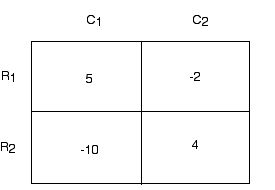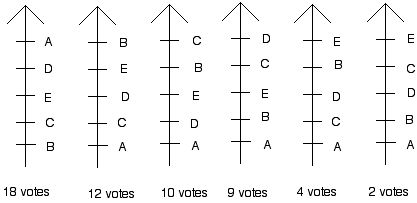Game Theory Sampler
Joseph Malkevitch
Mathematics and Computing Dept.
York College (CUNY)
Jamaica, New York 11451
email: jmalkevitch@york.cuny.edu
web page:
http://www.york.cuny.edu/~malk
Games I
Players named Row and Column independently choose a row (choice of two) and column (choice of two), respectively. The "payoff" is shown in the cell at the intersection of the chosen row/column pair. For example if Row plays Row 2 and Column plays Column I, Row loses 20 and Column wins 4.
|
|
Column I
|
Column II
|
|
Row 1
|
(-4,-4)
|
(4, -20)
|
|
Row 2
|
(-20, 4)
|
(1, 1)
|
i. How should Row and Column play this game to achieve his/her best result if the game is played:
a. Once?
b. Many times?
ii. Can you think of "real world situations" where this game would be a suitable model?
Games II
Players named Row and Column independently choose a row (choice of two) and column (choice of two), respectively. The "payoff" is shown in the cell at the intersection of the chosen row/column pair. The payoffs shown are from Row's point of view. Column's payoff is the negative of the number shown.

i. Is this a fair game?
ii. How should Row and Column play the game to achieve his/her best result if the game is played:
a. Once?
b. Many times?
Two-sided Markets
8 hospitals (left) and 8 medical students (right) have ranked each other as indicated in the tables below. For example Hospital 5 has ranked Medical Student 2, second, While Medical Student 4 has ranked Hospital 2 fourth.

i. What is a reasonable way to pair off the hospitals and medical students?
ii. Can you give other "real world" situations that have a similar "flavor" to this problem?
Elections
The ballots below show the rankings of 55 faculty for 5 choices of textbooks. Which book deserves to be selected as the choice for the group?

(Note: There is no indifference; higher preferences towards the top.)
Bankruptcy
There are three merchants who have
verified claims against the remaining assets of a small company. What would be a fair way to settle the claims in each case?
Example 1:
Claimant A B C (Assets Remaining: $200)
Claim $30 $100 $100
Example 2:
Claimant A B C (Assets Remaining: $200)
Claim $30 $200 $300
Apportionment
The four divisions of a college, Arts, Sciences, Business, and Teacher Education have enrollments of:
2,180
1,880
1,420
640
A wealthy alumna of the college has decided to donate 30 scholarships to attract new students based on the different divisions' enrollment.
What is a fair way to assign the 30 scholarships to each division?
What would be a fair assignment if there were 31 scholarships?
Fair Division
Bob (B) and Alvin (A) are siblings and have each, without the input of the other, assigned a dollar value to several items that their mother Nancy has willed to them. Each of the brothers has enough cash to make payments to the other in order to equalize any possible division that is suggested.
A B
Turkish Rug $1100 $1800
Stamp Collection $1900 $1200
Book Collection $20000 $30000
Ethnic Jewelry $6000 $5000
What would be a fair way to handle the situation? (What would you do if the brothers had listed the same amount for some items?)
Cost Sharing I
Towns A and B with populations of 12 and 8 (in hundreds of thousands) need to build a new sewage treatment plant.
Stand alone costs (in millions of dollars):
{A} = 160 {B} = 90
Joint cost: {A, B} = 200
How should A and B proceed?
Cost Sharing II
Towns A, B, and C with populations of 12, 10, and 8 (in hundreds of thousands) need to build a new sewage treatment plant.
Example 1:
Stand alone costs (in millions of dollars):
{A} = 150 {B} = 120 {C} = 90
Joint costs:
{A, B} = 240 {A, C} = 220 {B, C} = 180
{A, B, C} = 325
How should A, B, and C proceed?
Example 2:
Stand alone costs (in millions of dollars):
{A} = 150 {B} = 120 {C} = 90
Joint costs:
{A, B} = 240 {A, C} = 220 {B, C} = 180
{A, B, C} = 315
How should A, B, and C proceed?
Legislative Fairness
The five towns in Rural County have populations of 7, 4, 3, 3, and 1 (in hundreds of thousands), respectively.
Is it fair for the representatives of these 5 towns to cast 7, 4, 3, 3, and 1 vote, respectively, where 10 votes are required to take action in the county legislature?
Weighted Voting Games
[12; 7, 6, 5, 2, 1] is a notation for an election system known as weighted voting. In this example there are 5 players, 1, 2, 3, 4, and 5 who cast a block of votes of size 7, 6, 5, 2, and 1 respectively. A group of players (coalition) can take "action" if the sum of the weights they cast exceeds the quota Q, in this case 12. Thus, in this example players 2, 3, and 5 can pass a bill. {2, 3, 5} is a winning coalition.
List all the winning coalitions for this "game." How might one measure the "power" of the different players in this voting environment?
How do you think the value of Q was arrived at? Does this value for Q seem reasonable?
Weighted Voting Games II
Look into the role of the Electoral College in electing the President of the United States.
Is the Electoral College an example of a weighted voting game?
What is the power of the players in this game?
Transplants
Which of these factors should be taken into account in deciding whether or not someone is a suitable candidate for a transplant?
How famous the patient is?
How wealthy the patient is?
How old the patient is?
How sick the patient is?
How long the patient has been waiting for a transplant?.
Measuring inequality
i. What is the difference between wealth and income?
ii. How might one measure the extent to which there is income or wealth inequality in two different countries?
iii. Should markets set the pay that a worker receives or should their be regulations which require "equal pay for equal work?"
iv. Should their be minimum wage laws?
Short list of important references:
Aumann, R. and S. Hart (Eds.) Handbook of Game Theory with Economic Applications, North-Holland, New York, Volume 1, (1992), Volume 2, (1994), Volume 3 (2002), Volume 4 (2015)
Balinski, M. and H.P. Young, Fair Representation, Yale University Press, New Haven, 1982.
Brams, S. and A. Taylor, Fair Division, Cambridge U. Press, New York, 1996.
Kuhn, H. (ed.), Classics in Game Theory, Princeton U. Press, Princeton, 1997.
Mc Lean, I. and A. Urken, Classics of Social Choice, U. Michigan Press, Ann Arbor, 1995.
Moulin, H., Axioms of Cooperative Decision Making, Cambridge U. Press, New York, 1988.
Robinson, J. and W. Webb, Cake-Cutting Algorithms, A K Peters, Natick, 1998.
Saari, D., Geometry of Voting, Springer-Verlag, New York, 1994.
Straffin, P., Game Theory and Strategy, Mathematical Association of America, Washington, 1993.
Taylor, A., Mathematics and Politics, Springer-Verlag, New York, 1995.
Young, H.P. (Ed.), Fair Allocation, American Mathematical Society, Providence, 1985.
Young, H.P., Equity, Princeton U. Press, Princeton, 1994.


